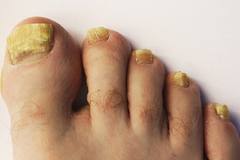 Our nails are made of keratin, which is similar in structure to bone but not the same. It works to protect parts of the skin and tends to be a telltale indicator for signs of internal problems.
Our nails are made of keratin, which is similar in structure to bone but not the same. It works to protect parts of the skin and tends to be a telltale indicator for signs of internal problems.
Most people are familiar with nail fungus infections and some of the toenail fungus treatment options. A lot of people have them and they are caused by the fact that toes tend to spend a lot of time in dark, damp environments and come into contact with a lot of things that may be carriers for fungal spores. However fingernails can also become infected by fungus. The first sign of infection is usually the nail becoming discolored and then thickening, especially along the tips. This looks very unpleasant and is an embarrassment to people who suffer from it. Avoid painting your nails with fingernail polish if this occurs as the polish will seal in humidity and give the fungus a better breeding environment. Deciding that the problem “will go away on its own” is also a bad idea. Treating this fungus is the smartest thing you can do.
Nail Fungus Treatments
There are several available toenail fungus treatment options, some of which include taking oral antifungal medications. Many people try to avoid this as some of these medications have rather harsh side effects. Antifungal solutions and ointments are available over the counter and are comparatively well priced. Several of these are alternative remedies that use natural oils with antifungal properties
The most popular and effective topical nail fungus treatment is Funginix. This is a combination of essential oils to both kill the fungus and help heal and moisturize the surrounding skin. No side effects have been reported during use of this natural medication.
Some important maintenance tips to encourage the healing process if you have a nail fungus infection:
- Keep a strict regimen of applying the antifungal solution to the infected nail(s)
- Maintain good hygiene, even if it means changing your regular habits
- Wash your hands regularly and use soap. Scrub your nails with a nail brush to remove any dirt that gets underneath or into the ridges of the nail
- Avoid using your nails as tools to open or unscrew anything as this can abrade the nail and allow the microorganisms that cause the fungal growth to bury themselves further in your nail and nail bed
- If you choose to go to a salon to get a manicure or pedicure, then make sure your chosen salon washes and sterilizes its equipment so you reduce the risk of contracting infection
- Don’t wear nail polish to cover up the embarrassment of having a fungal infection. The polish will hold moisture inside the nail and nail bed, encouraging fungal growth and further damage to the area.
- Use, and don’t share your own nail maintenance tools, like clippers, file, cuticle stick, etc. as this lowers the chance of contracting a fungal infection
- Wash your hands and feet regularly and dry them thoroughly.
- Catching and treating a nail fungus infection early on will avoid problems in the future. Having the antifungal solution available is the best safety tip.
- Use gloves when dealing with chemicals to avoid exposing your fingernails to futher damage
If you find that the infection persists, seek advice from your medical professional as there may be other symptoms and problems that linger unseen in your body that should be addressed.
Tags: nail fungus infections, natural remedies, toenail fungus symptoms, toenail fungus treatment





